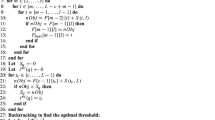Abstract
This research proposes a measure called cluster similar index (CSI) to evaluate the similarity of cluster for discrete elements. The CSI is used as a criterion to build the automatic fuzzy clustering algorithm. This algorithm can determine the suitable number of clusters, find the elements in each cluster, give the probability to belong to the clusters of each element, and evaluate the quality of the established clusters at the same time. The proposed algorithm can perform quickly and effectively by the established MATLAB procedure. Several numerical examples illustrate the proposed algorithm and show the advantages in comparing with the existing ones. Finally, applying the proposed algorithm in the image recognition shows potentiality in the reality of this research.







Similar content being viewed by others
References
Hung, W.L., Yang, J.H.: Automatic clustering algorithm for fuzzy data. J. Appl. Stat. 42, 1503–1518 (2016)
Tai, V.V., Pham-Gia, T.J.: Clustering probability distributions. Appl. Stat. 37, 1891–1910 (2010)
Tai, V.V., Thao, N.T.: Cluster similar of cluster for probability density functions. Commun. Stat. Theory Methods 47(8), 1792–1811 (2017)
Tai, V.V., Trung, N.T., Trung, V.D., Vinh, H.H., Thao, N.T.: Modified genetic algorithm-based clustering for probability density functions. J. Stat. Comput. Simul. 87(10), 1964–1979 (2017)
Chen, J., Hung, W.: An automatic clustering algorithm for probability density functions. J. Stat. Comput. Simul. 85(15), 3047–3063 (2005)
Goh, A., Vidal, R.: Unsupervised Riemannian clustering of probability density functions. ECML PKDD Part I, 377–392 (2008)
Tai V.V., Dinh P.T., Dung T.T.: Automatic genetic algorithm in clustering for discrete elements. Comput. Stat. Simul. Commun. https://doi.org/10.1080/03610918.2019.1588305
Tai, V.V.: \(L^1\)-distance and classification problem by Bayesian. J. Appl. Stat. 44(3), 385–401 (2017)
Tai, V.V., Thao, N.T.: Similar coefficient of cluster for discrete elements. Sankhya B Indian J. Stat. 80(1), 19–36 (2008)
Lissack, T., Fu, K.S.: Error estimation in pattern recognition via distance between posterior density functions. Inform. Theory IEEE Trans. 22, 34–45 (1976)
Johnson, R.A., Wichern, D.W.: Applied Multivariate Statistical Analysis. Prentice Hall Englewood Cliffs, New York (1992)
Keinosuke, F.: Introduction to Statistical Pattern Recognition. Academic, New York (1990)
MacQueen, J.: Some methods for classification and analysis of multivariate observations. In: Proceedings of the Fifth Berkeley Symposium on Mathematical Statistics and Probability, pp. 281–297. Oakland (1967)
Babuska, R., Verbruggen, H.B.: An overview of fuzzy modelling for control. Control. Eng. Pract. 4(11), 1593–1606 (1996)
Pal, N.R., Bezdek, J.C.: On cluster validity for the fuzzy c-means model. Fuzzy Syst. IEEE Trans. 3, 370–379 (1995)
Dunn, J.C.: A fuzzy relative of the ISODATA process and its use in detecting compact well-separated clusters. J. Cybern. 3, 32–57 (1973)
Xie, X.L., Beni, G.: A validity measure for fuzzy clustering. IEEE Trans. Pattern Anal. Mach. Intell. 13(8), 841–847 (1991)
Hubert, L., Arabie, P.: Comparing partitions. J. Classif. 2, 193–218 (1985)
Jorge, M., Santos, J.M., Embrechts, C.: On the use of the adjusted rand index as a metric for evaluating supervised classification. Artif. Neural Netw. ICANN 2009(5769), 175–184 (2009)
Bora, D.J., Gupta, A.K.: Impact of exponent parameter value for the partition matrix on the performance of fuzzy C means algorithm. Int. J. Sci. Res. Comput. Sci. Appl. Manage. Stud. 3(3), 1–5 (2014)
Fadili, M.J.: On the number of clusters and the fuzziness index for unsupervised FCA application to bold FMRI time series. Med. Image Anal. 5(1), 55–67 (2001)
Yu, J., Cheng, Q., Huang, H.: Analysis of the weighting exponent in the FCM. IEEE Trans. Syst. Man Cybern. Part B Cybern. 34(1), 634–639 (2004)
Richard, J.H., James, C.B.: Recent convergence results for the fuzzy c-means clustering algorithms. J. Classif. 5, 237–247 (1981)
Tai, V.V., Thao, N.T.: Fuzzy clustering of probability density function. J. Appl. Stat. 44(4), 583–601 (2017)
Kaufman, L., Rousseeuw, P.: Clustering by Means of Medoids. North-Holland, Amsterdam (1987)
Lauritzen, S.L.: The EM algorithm for graphical association models with missing data. Comput. Stat. Data Anal. 19, 191–201 (1995)
Ester, M., Kriegel, H.P., Sander, J., Xu, X.: A density-based algorithm for discovering clusters in large spatial databases with noise. In: KDD Proceeding, vol. 1966, pp. 226–231 (1986)
Haralick, R.M.: Statistical and structural approaches to texture. Proc. IEEE 67, 786–804 (1979)
Author information
Authors and Affiliations
Corresponding author
Rights and permissions
About this article
Cite this article
Vovan, T., Nguyenhoang, Y. & Danh, S. An Automatic Fuzzy Clustering Algorithm for Discrete Elements. J. Oper. Res. Soc. China 11, 309–325 (2023). https://doi.org/10.1007/s40305-021-00388-z
Received:
Revised:
Accepted:
Published:
Issue Date:
DOI: https://doi.org/10.1007/s40305-021-00388-z




